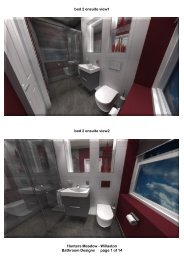Keep Your Home Free From Damp and Mould
This leaflet explains how condensation forms and how you can keep it to a minimum, so reducing the risk of dampness and mould growth.
This leaflet explains how condensation forms and how you can keep it to a minimum, so reducing the risk of dampness and mould growth.
- No tags were found...
Create successful ePaper yourself
Turn your PDF publications into a flip-book with our unique Google optimized e-Paper software.
<strong>Keep</strong> your<br />
home free<br />
from damp<br />
<strong>and</strong> mould<br />
<strong>Damp</strong> can cause mould on walls <strong>and</strong> furniture <strong>and</strong> make window frames rot. <strong>Damp</strong> cold housing encourages the growth<br />
of mould <strong>and</strong> mites, as mites feed on moulds <strong>and</strong> can increase the risk of respiratory illnesses in some people.<br />
Some damp is caused by condensation. This leaflet explains how condensation forms <strong>and</strong> how you can keep it to a<br />
minimum, so reducing the risk of dampness <strong>and</strong> mould growth.
First steps against condensation<br />
You will need to take proper steps to deal with the condensation, but meanwhile there are some<br />
measures you can take right away. Wipe down the windows <strong>and</strong> sills every morning. Wring out the<br />
cloth rather than drying it on a radiator.<br />
First steps against mould<br />
First treat the mould already in your home. If you deal with the basic problem, mould should not<br />
reappear. To kill <strong>and</strong> remove mould, wipe down walls <strong>and</strong> window frames with a fungicidal wash<br />
which carries a Health <strong>and</strong> Safety Executive ‘approval number’. Follow the manufacturer’s instructions precisely. Dry-clean<br />
mildewed clothes, <strong>and</strong> shampoo carpets. Disturbing mould by brushing or vacuum cleaning can increase the risk of respiratory<br />
problems. The only lasting way of avoiding severe mould is to eliminate dampness.<br />
Is it condensation?<br />
Condensation is not the only cause of damp.<br />
It can also come from:<br />
• Leaking pipes, wastes or overflows.<br />
• Rain seeping through the roof where a tile or slate is missing, spilling from a blocked gutter,<br />
penetrating around window frames, or leaking through a cracked pipe.<br />
• Rising damp due to a defective dampcourse or because there is no damp-course.<br />
These causes of damp often leave a ‘tidemark’ <strong>and</strong> you should have the necessary repairs carried<br />
out to remove the source of damp. If your home is newly built it may be damp because the water<br />
used during its construction (e.g. in plaster) is still drying out. If your home is damp for any of<br />
these reasons it may take weeks of heating <strong>and</strong> ventilating to dry out. Using a dehumidifier will<br />
help. If you do not think the damp comes from any of these causes, it is probably condensation.<br />
What is condensation?<br />
There is always some moisture in the air, even if you cannot see it. If<br />
the air gets colder it cannot hold all the moisture <strong>and</strong> tiny drops of<br />
water appear. This is condensation. You may notice it when you see<br />
your breath on a cold day, or when the mirror mists over when you<br />
have a bath. Condensation occurs mainly during cold weather,<br />
whether it is raining or dry. It does not leave a ‘tidemark’. It appears<br />
in places where there is little movement of air. Look for it in corners,<br />
on or near windows, in or behind wardrobes <strong>and</strong> cupboards. It often forms on north-facing walls.<br />
How to avoid condensation<br />
These four steps will help you reduce the condensation in your home.<br />
1. Produce less moisture<br />
Some ordinary daily activities produce a lot of moisture very quickly.<br />
Cooking: To reduce the amount of moisture, cover pans <strong>and</strong> do not leave on heat unnecessarily<br />
Paraffin <strong>and</strong> portable flueless bottled-gas heaters: These heaters put a lot of moisture into the air –<br />
one gallon of gas or paraffin produces about a gallon of water. If you have a problem with<br />
condensation, try to find alternative means of heating.<br />
Washing clothes: Put washing outdoors to dry if you can. Or put it in the bathroom with the door<br />
closed <strong>and</strong> the window open or fan on. It is best to fit a fan that can be switched to run continuously<br />
for clothes drying. If you have a tumble dryer make sure you vent it to the outside (unless it is the<br />
self-condensing type). DIY kits are available for this.
2. Ventilate to remove the moisture<br />
You can ventilate your home without making draughts. Some ventilation is needed to get rid of<br />
moisture being produced all the time, including that from people’s breath. <strong>Keep</strong> a small window<br />
ajar or a trickle ventilator open all the time if possible, <strong>and</strong> especially when someone is in the room.<br />
You need much more ventilation in the kitchen <strong>and</strong> bathroom when cooking, washing up, bathing<br />
<strong>and</strong> drying clothes. This means opening the windows wider.<br />
Close the kitchen <strong>and</strong> bathroom doors when these rooms are in use even if your kitchen or<br />
bathroom has an extractor fan. Doing this will help stop the moisture reaching other rooms,<br />
especially bedrooms, which are often colder <strong>and</strong> more likely to get condensation.<br />
Allow space for the air to circulate in <strong>and</strong> around your furniture. Open doors to ventilate cupboards <strong>and</strong> wardrobes. Leave space<br />
between the backs of wardrobes <strong>and</strong> the wall. Where possible, position wardrobes <strong>and</strong> furniture against internal walls, i.e. walls<br />
which have a room on both sides, rather than against outside walls.<br />
When you have a curtain or blind drawn, it makes the surface of the window cooler <strong>and</strong> increases condensation, especially with<br />
single glazed windows.<br />
3. Heat your home a little more<br />
In cold weather, the best way to keep rooms warm enough to avoid condensation is to keep low<br />
background heating on all day, even when there is no one at home. This is very important in flats<br />
<strong>and</strong> bungalows <strong>and</strong> other dwellings where the bedrooms are not above a warm living room. If<br />
you have central heating set it to provide background warmth in all rooms including unused<br />
rooms.<br />
Dehumidifiers will help dry out damp in newly built houses. They can also help reduce<br />
condensation but they are of limited use in cold damp rooms.<br />
Points to remember<br />
Produce less moisture:<br />
• Cover pans<br />
• Dry clothes outdoors<br />
• Vent your tumble dryer to the outside<br />
• Avoid using paraffin or flueless bottled gas heaters<br />
Ventilate to remove moisture:<br />
• Ventilate all the time, especially when someone is in<br />
• Increase ventilation of the kitchen <strong>and</strong> bathroom when in use<br />
<strong>and</strong> shut the door<br />
• Ventilate cupboards, wardrobes <strong>and</strong> blocked chimneys<br />
Heat your home a little more<br />
• if possible, keep low background heat on all day, with<br />
background ventilation<br />
• find out about benefits, rebates <strong>and</strong> help with fuel bills
















